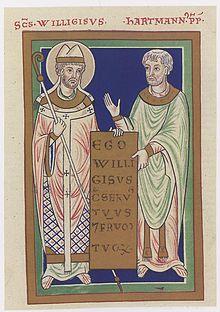Willigis
Willigis , rarely Williges or Willegis (* around 940 in Schöningen ; † February 23, 1011 in Mainz ) was Archbishop of Mainz . Willigis is a saint of the Roman Catholic Church . Remembrance day is the day of his death.
Life
Willigis was born around 940 in Schöningen in what is now Lower Saxony as the son of free but non-aristocratic parents. Through his mentor, Bishop Volkold von Meißen, he probably came to the court of Emperor Otto I in 969. From 971, Willigis held the office of Chancellor, which he also retained under Otto II . In January 975 he was made Archbishop of Mainz by Otto II .
Willigis is considered a key figure in the history of the Archdiocese of Mainz . Like few else, he knew how to direct the fortunes of the Church and Empire in the early Middle Ages and to expand the importance of the ecclesiastical province of Mainz . Since his aegis , the dignity of Imperial Chancellor for Germania was mostly associated with the Archdiocese of Mainz. When he was elected archbishop in 975, Pope Benedict VII gave Willigis a privilege with the appointment of papal vicar for life. "Willigis should have precedence, the preeminence, over the other archbishops and bishops of the northern Alpine empire in a comparable way [like the Pope over the bishops as a whole]. And obviously this preeminence should pass to his successors, as is the case with the Popes Willigis was to make use of his preeminence on two expressly mentioned occasions: at the organization of synods and at the consecration and coronation of the king. "
In 983 Willigis took part in Otto II's Reichstag in Verona , where he received the Veronese donation on June 13, 983 , which granted the archbishopric areas from Ingelheim to Heimbach and Kaub as well as the area on both sides of the lower Nahe and the Rheingau to the right of the Rheines agreed. The donation established a large part of the later electoral state ( Kurmainz ), over which the archbishop ruled as sovereign.
After Otto II's death on December 7, 983, his three-year-old son Otto III. new king. Until he came of age, his mother, the Empress Theophanu , was to act as imperial administrator . After her death in 991, Willigis became the de facto regent of the empire until Otto III. 994 was declared of legal age. This resulted in tribute payments to him, which made the archbishopric one of the richest churches in the West .
In 996 Willigis accompanied Otto III. to Rome , where this the Pope John XV. wanted to support the Roman noble family of the Crescentier . After Johannes 'sudden death, Otto proclaimed his cousin Brun to be the new Pope Gregory V. Gregor was ordained the new Bishop of Rome with Willigis' participation. After the early death of Otto III. on January 24, 1002, at the instigation of Willigis' Heinrich II, was elected the new king and crowned by him on June 7, 1002 in the Mainz Cathedral . Willigis, highly respected throughout the empire, was referred to by contemporaries as "the emperor and the empire's father". Willigis died on February 23, 1011 in Mainz and was buried in St. Stephen's Church in Mainz .
The builder
Willigis is the master builder of the Mainz Cathedral , which still exists today (although with some modifications). It is mostly assumed that Willigis began building the cathedral when he took office in 975. The cathedral was intended to illustrate the importance and position of the Archdiocese of Mainz in the empire and the general church. Pastoral reasons did not form the basis of its conception. The cathedral was so big that at that time all citizens of the city would have found a place in it. It was the first building of this size north of the Alps.
According to another opinion, the start of construction is dated around 998. In 997, Emperor Otto III, who had fallen out with Willigis, obtained an indult from the Pope . This made it impossible for the Archbishop of Mainz to celebrate mass in the coronation church of the German kings in Aachen, which belonged to the diocese of Liège and thus to the Cologne church province. As a result, he would have been deprived of the opportunity to be crowned king. Willigis could therefore have planned to circumvent this papal decision by designating a new coronation church for the German kings: the new Mainz Cathedral. In fact, the next two kings, Heinrich II and Konrad II (1024), were also crowned in Mainz Cathedral.
It is certain that the cathedral was completed in 1009. On the day of the planned consecration (or the day before) the cathedral burned down (probably as a result of the festival illumination). Unbroken from this, the 69-year-old Willigis began with the reconstruction. Willigis also built the collegiate church of St. Stephan in Mainz from approx. 990 . Willigis was buried there because his bishop's church, the cathedral, had not yet been restored sufficiently. The St. Viktor Abbey before Mainz was founded in 994 or 995 and in the presence of Otto III. inaugurated by Archbishop Willigis. In addition, Willigis awarded the St. Martin Basilica in Bingen the rank of collegiate church and possibly initiated construction measures for it; He also had the Drusus Bridge , a stone bridge over the Nahe, built in Bingen . The main features of the Willigis Bridge in Aschaffenburg , a wooden bridge , were also built by him.
Commemoration

A collection of hymns, antiphons and responsories was created around 1150 and assigned to Hartmann, Dompropst and Provost in St. Stephan at the time of Archbishop Heinrich Felix von Harburg . Whether this collection was ever used as the basis for Willigis celebrations in the High Middle Ages cannot be established; the Latin texts of the manuscript were later printed in full in books twice, in 1675 and 1869. After the dissolution of the Stephansstift at the beginning of the 19th century, the manuscripts came first to St. Petersburg and later to the Russian State Library in Moscow.
The Willigisplatz in front of the Catholic parish church of St. Stephan was named after him. The Bischöfliche Willigis-Gymnasium and the Willigis-Realschule bear his name. A street name and the Willigis Bridge in Aschaffenburg remind of him.
swell
- Thietmar von Merseburg : Chronicle . Translated by Werner Trillmich. Darmstadt 1957 (Freiherr vom Stein Memorial Edition 9). Latin text in Robert Holtzmann (Hrsg.): Scriptores rerum Germanicarum, Nova series 9: The Chronicle of Bishop Thietmar von Merseburg and their Korveier revision (Thietmari Merseburgensis episcopi Chronicon) Berlin 1935 ( Monumenta Germaniae Historica , digitized version )
literature
Lexicon article
- Karl Uhlirz : Willigis . In: Allgemeine Deutsche Biographie (ADB). Volume 43, Duncker & Humblot, Leipzig 1898, pp. 282-289.
- Max Georg Kellner: Willigis. In: Biographisch-Bibliographisches Kirchenlexikon (BBKL). Volume 13, Bautz, Herzberg 1998, ISBN 3-88309-072-7 , Sp. 1336-1338.
- Alois Gerlich : Willigis, Archbishop of Mainz . In: Lexicon of the Middle Ages (LexMA). Volume 9, LexMA-Verlag, Munich 1998, ISBN 3-89659-909-7 , Sp. 214-216.
Representations
- Josef Heinzelmann : Traces of the early history of St. Stephan in Mainz. A contribution to a discussion that has not yet been held. In: Archive for Middle Rhine Church History. Vol. 56 (2004), pp. 89-100.
- Josef Heinzelmann: Mainz between Rome and Aachen. Archbishop Willigis and the construction of the Mainz Cathedral. In: Yearbook for West German State History. Vol. 30 (2004), pp. 7-32 PDF file .
- Peter Aufgebauer : The Archbishop of Mainz Willigis (975-1011) and his work on the Eichsfeld. In: Thomas T. Müller, Maik Pinkert and Anja Seeboth (eds.): Bishop Burchard in his time. Proceedings of the biographical and regional colloquium from October 13th to 15th, 2000 in Heilbad Heiligenstadt (= contributions from the archives in the Eichsfeld district. Vol. 1). Cordier, Heiligenstadt 2001, pp. 42–57.
- Felicitas Janson, Barbara Nichtweiß (Ed.): Basilica Nova Moguntina. 1000 years of Willigis Cathedral St. Martin in Mainz. Publications Diocese of Mainz, Mainz 2010, ISBN 978-3-934450-43-1
- Regina Heyder, Barbara Non-White (ed.): Willigis von Mainz. Environment - effect - interpretation. Contributions to the Willigis anniversary in St. Stephan. Echter, Würzburg 2014, ISBN 978-3-429-03795-6 .
- Matthias Dietz-Lenssen: Willigis. Church prince, arch chancellor, builder. Agency & Verlag Bonewitz, Bogenheim 2020, ISBN 978-3-9818438-5-9
Web links
Remarks
- ↑ Ernst-Dieter Hehl : A cathedral for king, empire and church. The cathedral building of Willigis and the building activity in Mainz in the 10th century . In: Felicitas Janson and Barbara Nichtweiss (eds.): Basilica Nova Moguntina. 1000 years of Willigis Cathedral St. Martin in Mainz. Mainz 2010, pp. 45–78, here p. 61.
- ^ Praise of an exemplary bishop , in: Mainzer Bistumsnachrichten No. 7, February 23, 2011
| predecessor | Office | successor |
|---|---|---|
| Ruprecht |
Archbishop of Mainz 975-1011 |
Erkanbald |
| personal data | |
|---|---|
| SURNAME | Willigis |
| ALTERNATIVE NAMES | Willing; Willegis |
| BRIEF DESCRIPTION | Archbishop of Mainz, saint of the Catholic Church |
| DATE OF BIRTH | around 940 |
| PLACE OF BIRTH | uncertain: Schöningen |
| DATE OF DEATH | February 23, 1011 |
| Place of death | Mainz |
